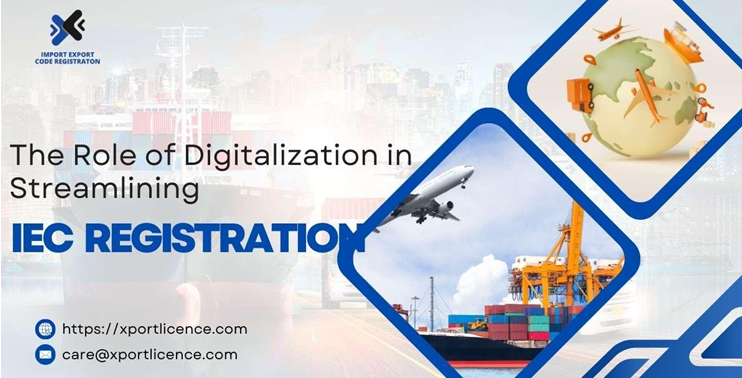The Role of Digitalization in Streamlining IEC Registration

Introduction
In the digital age, businesses across the globe are embracing technology to streamline operations and improve efficiency. One significant area where digitalization has made a remarkable impact is in the registration processes for various licenses and permits. In India, the Import Export Code (IEC) registration, a mandatory requirement for businesses involved in international trade, has greatly benefited from digital advancements. This blog explores how digitalization has transformed the IEC Registration process, making it more accessible, efficient, and user-friendly for entrepreneurs and businesses.
1. Simplified Application Process
Gone are the days when businesses had to navigate through cumbersome paperwork and visit multiple government offices to obtain their IEC registration. The digitalization of the process has led to the creation of online portals where applicants can submit their forms and required documents with just a few clicks. The Directorate General of Foreign Trade (DGFT) has developed an intuitive online system that guides users through each step, reducing the complexity and time involved in the application process.
2. Reduced Processing Time
One of the most significant advantages of digitalizing the IEC registration process is the substantial reduction in processing time. In the past, it could take several weeks or even months for applications to be reviewed and approved. Today, with automated systems and digital verification processes, the time required to obtain an IEC registration has been drastically shortened. In many cases, applicants receive their IEC code within a few days, enabling businesses to commence their import-export activities without undue delays.
3. Increased Transparency and Accountability
Digital platforms offer a high degree of transparency and accountability, which is crucial for building trust between businesses and regulatory authorities. The online IEC registration system allows applicants to track the status of their applications in real time. Automated notifications and updates ensure that applicants are informed of any issues or additional requirements promptly. This transparency helps to eliminate ambiguities and enhances the overall user experience.
4. Cost-Effective Solution
Digitalization also brings about significant cost savings for both businesses and the government. The need for physical forms, postage, and in-person visits to government offices is eliminated, reducing expenses associated with the registration process. For small and medium-sized enterprises (SMEs), these savings can be particularly beneficial, allowing them to allocate resources more effectively towards their core business activities.
5. Improved Data Security
The digital IEC registration process incorporates advanced security measures to protect sensitive business information. Encryption, secure login credentials, and regular system audits ensure that the data submitted by applicants is safeguarded against unauthorized access and cyber threats. This emphasis on data security instills confidence in businesses, encouraging more entities to engage in international trade.
6. Enhanced Accessibility
Digital platforms make the IEC registration process accessible to a wider audience. Entrepreneurs and businesses located in remote areas can now apply for their IEC registration without the need to travel to urban centers. This inclusivity supports the government’s vision of promoting ease of doing business and fostering economic growth across all regions.
7. Real-Time Data Integration
Digital systems enable real-time data integration, which is crucial for the efficient functioning of trade and regulatory activities. The integration of IEC registration data with other government databases, such as customs, tax, and trade facilitation platforms, ensures seamless operations and minimizes the risk of discrepancies. This interconnected approach reduces redundancies and enhances the overall efficiency of trade processes.
8. Automated Compliance Checks
Digital platforms incorporate automated compliance checks that verify the accuracy and completeness of the submitted information. These checks help identify any discrepancies or missing details instantly, allowing applicants to rectify issues promptly. Automated compliance ensures that businesses adhere to regulatory standards from the onset, reducing the risk of future complications and penalties.
9. User-Friendly Interfaces
The design of user-friendly interfaces for online IEC registration portals plays a significant role in streamlining the process. These interfaces are crafted to be intuitive and easy to navigate, even for individuals with limited technical knowledge. Clear instructions, helpful tooltips, and accessible customer support enhance the user experience, making the registration process straightforward and stress-free.
10. Continuous Improvement and Feedback Loops
Digital platforms facilitate continuous improvement through feedback loops. Businesses can provide feedback on their registration experience, which authorities can use to identify pain points and areas for enhancement. This iterative approach ensures that the IEC registration process evolves in response to user needs and technological advancements, maintaining its efficiency and effectiveness over time.
Note: You can also Apply for IEC Code Renewal from our online portal
Conclusion
Digitalization has undeniably revolutionized the IEC registration process, bringing about a host of benefits that streamline operations, enhance efficiency, and foster greater transparency. By simplifying the application process, reducing processing times, and ensuring data security, digital platforms have made it easier than ever for businesses to obtain their IEC registration and participate in international trade. As technology continues to evolve, we can expect further improvements and innovations that will continue to support and empower businesses on their journey to global success.





